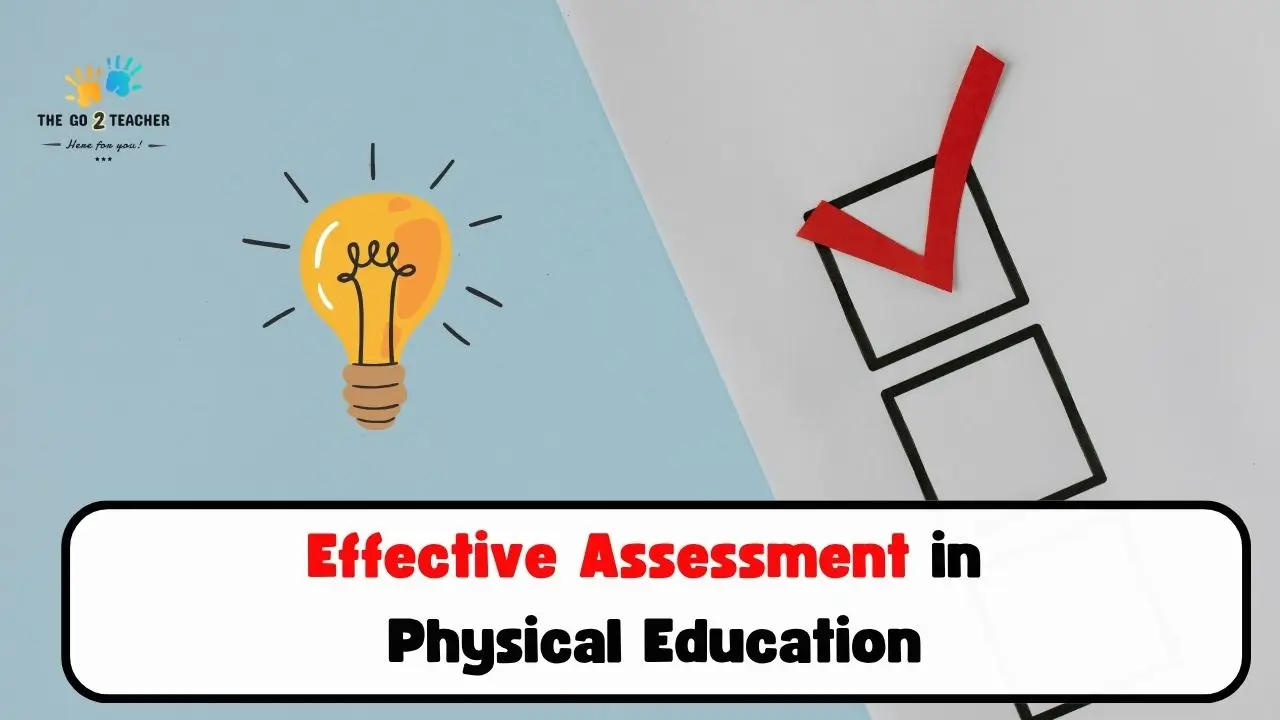Effective Assessment in Physical Education: Strategies for Primary & Secondary Teachers
Jun 4, 2025


Kas
Assessment in P.E. can be very challenging, especially if you’re new to the subject area or haven’t had the opportunity to observe experienced P.E. teachers using a range of assessment tools and techniques. I’ve been very fortunate early in my career to have had wonderful mentors who applied evidence-based assessment models when evaluating students in physical education.
I use the word “fortunate” because, unfortunately, in my experience (and maybe you’ve seen this too), very few physical education teachers use evidence-based or even structured assessment methods to grade their students. More often than not, assessment tends to be observational in nature—essentially a gut feeling or judgment based on a student’s performance in a particular game or activity.
Teachers might rely on this approach for a number of reasons:
- They’ve never been shown how to assess in P.E.
- It’s difficult to assess due to the dynamic and fast-paced nature of the subject.
- Outdoor environments make it hard to use traditional tools like pen and paper.
- Units of work may be poorly planned, offering no clear structure or guidance on assessment points.
- There’s a lack of training or professional development.
While none of these are valid excuses, I do empathise. When I got my first five-week contract as an HPE teacher straight out of university, I was thrown in at the deep end. I had to teach an entire unit across a primary school and finalise end-of-year reports while covering for a teacher on leave. The school was trauma-informed and had many students with complex behavioural needs. Walking into that environment as a brand-new teacher, with little behaviour management experience, no support network, and no existing relationships with staff or students—well, my lessons and assessments were a bit of a train wreck. I spent most of my time just keeping my head above water, managing meltdowns mid-lesson. Assessment was the last thing on my mind!
Although numerous valid and reliable assessment tools exist (like GPAI or skill checklists), many teachers do not use them regularly due to lack of training, resources, or time. Hastie, P. A., & Curtner-Smith, M. D. (2006).
Influence of a tactical games model on the game play and practice of physical education teachers. Research Quarterly for Exercise and Sport, 77(1), 26–35.Morgan & Bourke (2008) identified that many teachers find it challenging to assess P.E. effectively because of large class sizes, unpredictable environments, and insufficient training in assessment strategies.
Kirk (2010) found that many physical education teachers lack formal training in assessment and often rely on unstructured observational judgment to grade students, which can be subjective and inconsistent.
I believe every P.E. teacher goes through a phase in their career where assessments feel unclear or clunky. We all stumble through a few poor attempts before eventually deciding to develop our skills and implement more effective strategies. There’s no shame in that—but there is a problem if we never attempt to improve. If we want our subject area to be taken seriously, we need to take an informed, accurate, and evidence-based approach to assessment, just like any other meaningful subject.
Students in P.E. deserve accurate assessments that fairly reflect their abilities and offer relevant feedback for improvement. We owe it to them to be at the top of our game when it comes to assessment.
This article isn’t a deep dive into why evidence-based assessment in P.E. is essential—that’s a topic for another day. Instead, it serves as a starting point in a series of articles discussing various assessment strategies in HPE.
Let’s look at a few assessment tools I regularly use in my primary and high school P.E. classes.

Games Performance Assessment Instrument (GPAI)
This is one of my favourite assessment tools—and arguably one of the most specific and effective protocols in physical education. I explore GPAIs in detail in another article, but here’s a brief overview of why they’re so valuable.
The GPAI was developed by Stephen Mitchell, Judith Oslin, and Linda Griffin—respected educators and experts in physical education. They’ve authored several key texts in the HPE field, including the Tactical Games Model and, of course, the GPAI itself, which is designed to assess both tactical and technical outcomes.
GPAIs are great because they assess students during a game or activity, rather than in isolation. This results in a more accurate reflection of a student’s ability to apply skills in context—under time pressure, with defensive players, and other game-related dynamics. Crucially, GPAIs let us assess tactical as well as technical skills.
It’s difficult—and often inauthentic—to evaluate tactical understanding outside of a game setting. For example, if we’re teaching students how to move into space to receive a pass during an invasion game, the best way to assess that knowledge is within a real game context. That’s where the strength of the GPAI lies.
The GPAI allows educators to assess students’ decision-making, skill execution, and tactical awareness within the context of actual game play—making the assessment more authentic and reflective of real performance. Oslin, J. L., Mitchell, S. A., & Griffin, L. L. (1998). The Game Performance Assessment Instrument (GPAI): Development and Preliminary Validation. Journal of Teaching in Physical Education, 17(2), 231–243.
In my opinion, GPAIs are excellent because they can be adapted to assess all game categories. Their structure is flexible enough to align with different assessment needs, school guidelines, or curriculum standards. A well-designed GPAI can provide insight into a student’s technical ability, tactical understanding, and even social-emotional skills like teamwork and communication.
Observational Checklist
If the GPAI is the king of assessments, then observational checklists are the prince. They’re simple, effective, and fundamental tools for assessing students—particularly useful in specific situations.
I use observational checklists mainly for formative assessment, or for summative assessment in the early primary years when I’m focusing on students’ fundamental movement skills (FMS).
Unlike the GPAI, which focuses on tactical performance in games, observational checklists are perfect for evaluating individual FMS like jumping, skipping, or balancing—often in standalone drills or activity stations. Since these assessments don’t require a full game setting, a more straightforward tool works best.
Checklists based on movement criteria have been shown to improve the objectivity and consistency of fundamental movement skill assessments, supporting both teaching and learning in physical education. Hardy, L. L., King, L., Farrell, L., Macniven, R., & Howlett, S. (2010). Fundamental movement skills among Australian preschool children. Journal of Science and Medicine in Sport, 13(5), 503–508.
Checklists typically use a basic scale such as ‘below standard,’ ‘at standard,’ and ‘above standard.’ What these levels look like depends on the student’s age, year level, and the learning intentions of your lesson or unit. A great feature of checklists is the ability to include movement cues to guide both instruction and assessment. For example, for a standing jump: “feet shoulder-width apart, bend at the knees, break at the waist, drive upwards through the feet,” and so on.
If you want to explore FMS and how to assess them further, check out our previous article

Peer Assessment
Peer assessment is another powerful tool—essentially any assessment protocol where the evaluator is a fellow student. Research shows that students can learn just as effectively—and sometimes even more so—from their peers than from a teacher. Peers tend to create a lower-pressure environment. Because they’re at a similar developmental level, they may explain techniques in a more relatable way. This makes feedback more approachable and encourages collaboration.
Peer assessments are especially valuable because they engage students in the assessment process and reinforce the assessor’s own learning. By observing others and identifying key movements or techniques, students solidify their own understanding through explanation and demonstration. They also learn from their peers’ mistakes and successes, creating a feedback loop that supports deeper learning.
Peer assessments are excellent formative tools that allow every student to engage in assessment—just from a different angle. Let this be the first of many conversations we have about assessments in HPE. With the right tools and approaches, assessment in P.E. doesn’t have to be intimidating—it can be meaningful, manageable, and even inspiring.
Peer assessment promotes cognitive engagement through the processes of evaluating peer work and receiving feedback, which can lead to improved learning outcomes. Topping, K. J. (1998). Peer Assessment Between Students in Colleges and Universities. Review of Educational Research, 68(3), 249–276.
So is that it for assessments in P.E?….. Nope not even close, the truth is it is almost the end of the term and my reports are due soon. Id love to keep chatting but I better get back to my marking! I’ll be back soon for part 2 of assessment in physical education!
Helpful Resources:
- Fundamental Movement Skills: Flash Cards + Circuit
- Coloured Cones For Teaching P.E! (Amazon)
- Coloured Sit Spots for behaviour management! (Amazon)
- Awesome Teacher Planner! (Amazon)
- How to create a better work life balance?
- Why are minor games important for students to learn?
- Emotional Regulation Posters
- Assessments for P.E- Ready to go
- What are invasion games?
- First time teaching P.E? Heres where to start!
